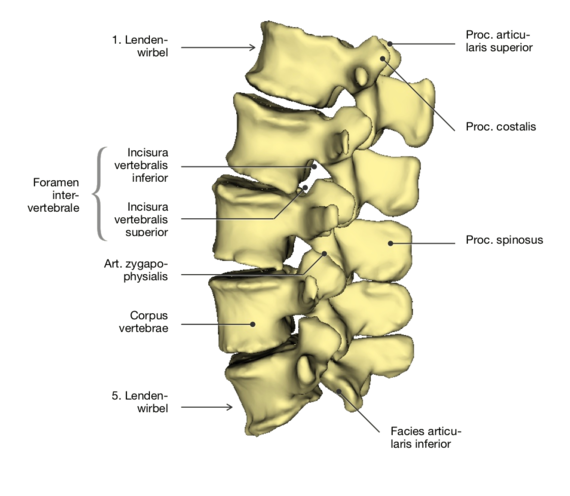Lendenwirbelsäule/en: Unterschied zwischen den Versionen
Becher (Diskussion | Beiträge) (Die Seite wurde neu angelegt: „right|570px|lumbar spine“) |
Becher (Diskussion | Beiträge) (Die Seite wurde neu angelegt: „The lumbar spine is the section of the spine that begins directly under the thoracic spine and ends at the sacrum. It consists of 5 lumbar ver…“) |
||
| Zeile 3: | Zeile 3: | ||
| − | + | The lumbar spine is the section of the [[Wirbelsäule|spine]] that begins directly under the thoracic spine and ends at the sacrum. It consists of 5 lumbar vertebrae. Furthermore, the lumbar spine represents the base of the trunk and is particularly strained by the upright gait. Like the cervical spine, it has a physiological forward curvature (lordosis).<br> | |
| − | + | Due to the heavy load, both the articular processes and their lumbar vertebrae are stronger than those of the rest of the spine. They have a transverse oval shape and are high and broad. The powerful joint processes (<i>Procc. articulares superior</i> and <i>inferior</i>) have slightly bevelled joint surfaces which are vertically and almost sagitally extended. Therefore, only limited or no rotation is possible. The massive vertebral arches enclose a triangular invertebral hole and unite dorsally to form a strong spinous process that is flattened on both sides. | |
| − | + | As in other parts of the spine, the intervertebral discs (intervertebral discs) and ligaments are located between the lumbar vertebrae.<br> | |
| − | + | The transverse processes become longer from the first to the third lumbar vertebra and then shorter again up to the fifth lumbar vertebra. They are also rib rudiments and are therefore referred to as <i>Procc. costales</i>. | |
| − | + | The <i>Procc. mamillares</i> (muscle humps), which are located on the outer surfaces of the upper processes of the joints, serve as insertions for autochthonous back muscles. | |
Version vom 2. Januar 2020, 13:52 Uhr
The lumbar spine is the section of the spine that begins directly under the thoracic spine and ends at the sacrum. It consists of 5 lumbar vertebrae. Furthermore, the lumbar spine represents the base of the trunk and is particularly strained by the upright gait. Like the cervical spine, it has a physiological forward curvature (lordosis).
Due to the heavy load, both the articular processes and their lumbar vertebrae are stronger than those of the rest of the spine. They have a transverse oval shape and are high and broad. The powerful joint processes (Procc. articulares superior and inferior) have slightly bevelled joint surfaces which are vertically and almost sagitally extended. Therefore, only limited or no rotation is possible. The massive vertebral arches enclose a triangular invertebral hole and unite dorsally to form a strong spinous process that is flattened on both sides.
As in other parts of the spine, the intervertebral discs (intervertebral discs) and ligaments are located between the lumbar vertebrae.
The transverse processes become longer from the first to the third lumbar vertebra and then shorter again up to the fifth lumbar vertebra. They are also rib rudiments and are therefore referred to as Procc. costales.
The Procc. mamillares (muscle humps), which are located on the outer surfaces of the upper processes of the joints, serve as insertions for autochthonous back muscles.
Die Lendenwirbelsäule zum freien Explorieren
| mit Annotationen | ohne Annotationen |
<segmenter border="1">https://dornheim.cloud/index.php/apps/segmenter/embedding/view?identifier=WNc02CvroFFl</segmenter>
weiterführende Links
